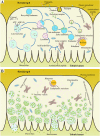Gene expression profiles in Malpighian tubules of the vector leafhopper Psammotettix striatus (L.) revealed regional functional diversity and heterogeneity
- PMID: 35057738
- PMCID: PMC8781387
- DOI: 10.1186/s12864-022-08300-6
Gene expression profiles in Malpighian tubules of the vector leafhopper Psammotettix striatus (L.) revealed regional functional diversity and heterogeneity
Abstract
Background: Many leafhoppers are known as pests and disease vectors of economically important plants. Previous studies of the physiological functions of vector leafhoppers have mainly focused on the salivary glands and the alimentary tract that are deemed to be associated with digestion, host defense and phytoplasma and/or virus transmission. By contrast, the significance of Malpighian tubules (MTs) is less studied. To clarify the physiological function of MTs of the vector leafhopper Psammotettix striatus that transmits phytoplasma triggering the wheat blue dwarf disease, we performed a transcriptome study on P. striatus MTs and compared gene expression profiles among different anatomical regions in the tubules (i.e., MT1+2, the anterior segment together with the sub-anterior segment; MT3, the inflated segment; and MT4, the distal segment).
Results: Transcriptome of P. striatus MTs generate a total of 42,815 high-quality unigenes, among which highly expressed unigenes are mainly involved in organic solute transport, detoxification and immunity in addition to osmoregulation. Region-specific comparative analyses reveal that all these MT regions have functions in osmoregulation, organic solute transport and detoxification, but each region targets different substrates. Differential expression and regional enrichment of immunity-related effector activities and molecules involved in phagocytosis and the biosynthesis of antimicrobial peptides among different regions indicate that MT1+2 and MT4 have the ability to eliminate the invading pathogens. However, in MT3 which secrets brochosomes to the integument and eggs as physical barriers, disulfide-isomerase, acidic ribosomal protein P and many other unigenes were highly expressed, which can be attractive candidate genes for future studies of the biosynthesis and the origin of brochosomes.
Conclusions: Psammotettix striatus MTs perform multiple physiological functions as versatile organs than just excretory organs with osmoregulatory function. Heterogeneity of physiological functions among different MT regions is related to organic solute transport, detoxification, immunity and brochosome biosynthesis in addition to osmoregulation, and each region targets different substrates. These functions may be helpful for P. striatus to resist pathogens from habitats and to utilize a wider range of host plants, which may assist the transmission and spread of phytoplasmas. The results provide potential molecular targets for the exploit of chemical and/or gene-silencing insecticides.
Keywords: Bioinformatics; Brochosome; Cicadellidae; Detoxification; Immunity; Organic solute transport; Osmoregulation; RNA-Seq; RT-qPCR.
© 2022. The Author(s).
Conflict of interest statement
The authors declare that they have no competing interests.
Figures







Similar articles
-
Morphology and histology of the digestive system of the vector leafhopper Psammotettix striatus (L.) (Hemiptera: Cicadellidae).Micron. 2012 Jun;43(6):725-38. doi: 10.1016/j.micron.2012.01.004. Epub 2012 Jan 28. Micron. 2012. PMID: 22341338
-
Screening of reference genes for gene expression study in different tissues from the transcriptome data of the vector leafhopper Psammotettix striatus.Gene. 2024 Nov 15;927:148696. doi: 10.1016/j.gene.2024.148696. Epub 2024 Jun 13. Gene. 2024. PMID: 38878986
-
Functional and evolutionary implications of protein and metal content of leafhopper brochosomes.Insect Biochem Mol Biol. 2023 Jun;157:103962. doi: 10.1016/j.ibmb.2023.103962. Epub 2023 May 11. Insect Biochem Mol Biol. 2023. PMID: 37178742
-
Malpighian Tubules as Novel Targets for Mosquito Control.Int J Environ Res Public Health. 2017 Jan 24;14(2):111. doi: 10.3390/ijerph14020111. Int J Environ Res Public Health. 2017. PMID: 28125032 Free PMC article. Review.
-
Multiple Functions of Malpighian Tubules in Insects: A Review.Insects. 2022 Oct 31;13(11):1001. doi: 10.3390/insects13111001. Insects. 2022. PMID: 36354824 Free PMC article. Review.
Cited by
-
Insights into Brochosome Distribution, Synthesis, and Novel Rapid-Release Mechanism in Maiestas dorsalis (Hemiptera: Cicadellidae).Insects. 2023 Aug 30;14(9):734. doi: 10.3390/insects14090734. Insects. 2023. PMID: 37754701 Free PMC article.
-
Malpighian tubules of Rhodnius prolixus: More than post-prandial diuresis.Front Insect Sci. 2023 Mar 30;3:1167889. doi: 10.3389/finsc.2023.1167889. eCollection 2023. Front Insect Sci. 2023. PMID: 38469518 Free PMC article. Review.
-
Diversity and Dynamics of Bacterial Communities in the Digestive and Excretory Systems across the Life Cycle of Leafhopper, Recilia dorsalis.Insects. 2023 Jun 12;14(6):545. doi: 10.3390/insects14060545. Insects. 2023. PMID: 37367361 Free PMC article.
References
-
- Beyenbach KW, Skaer H, Dow JAT. The developmental, molecular, and transport biology of Malpighian tubules. Annu Rev Entomol. 2010;55:351–374. - PubMed
-
- Dow JAT, Davies SA. The Malpighian tubule: rapid insights from post-genomic biology. J Insect Physiol. 2006;52:365–378. - PubMed
-
- Dow JAT. Insights into the Malpighian tubule from functional genomics. J Exp Biol. 2009;212:435–445. - PubMed
-
- Yuan Y-Y, Li M, Fan F, Qiu X-H. Comparative transcriptomic analysis of larval and adult Malpighian tubules from the cotton bollworm Helicoverpa armigera. Insect Sci. 2018;25:991–1005. - PubMed
MeSH terms
Substances
LinkOut - more resources
Full Text Sources

